Total Solar Eclipse in Spain – August 12, 2026
The Total Solar Eclipse of 12 August 2026 – Europe’s First in 27 Years
On August 12, 2026, Europe will witness its first total solar eclipse in nearly three decades. The path of totality will touch Greenland, western Iceland, and northern Spain, where maximum totality will reach up to 2 minutes and 18 seconds.
Occurring just one day before the peak of the Perseid meteor shower, the event offers a rare astronomical double feature.
This eclipse is as much about weather and sight lines as it is about astronomy. The eclipsed Sun will remain low in the sky, peaking at only 26° above the horizon, with even lower altitudes in Spain. This makes site selection and clear horizons crucial for observers.
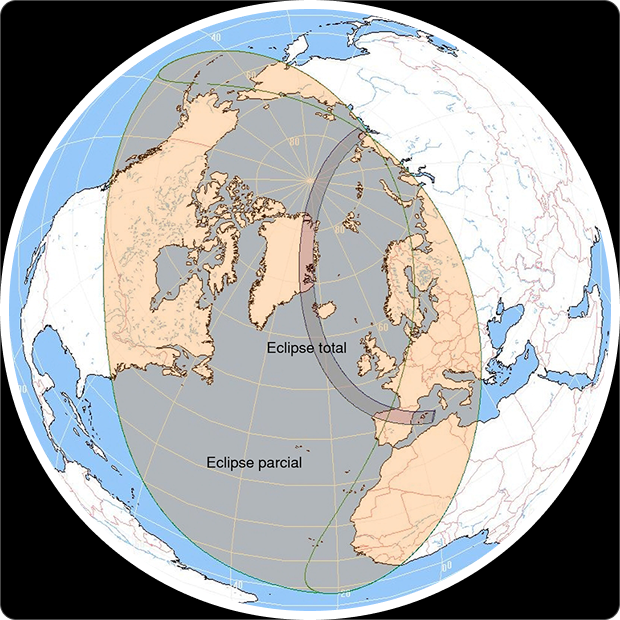
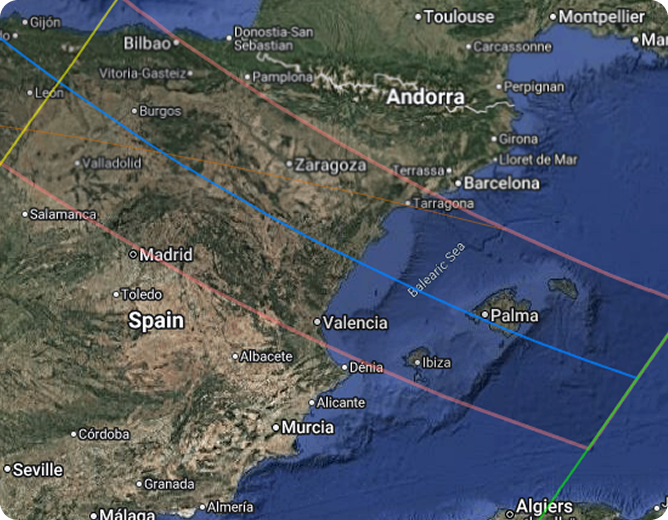
The solar Eclipse in Spain
The path of totality in Spain stretches from A Coruña on the Atlantic coast to Valencia and Palma de Mallorca on the Mediterranean, crossing cities such as Oviedo, León, Burgos, Zaragoza, and Santander. It is the first total eclipse visible from the Iberian Peninsula since 1905, and the first in Spain territory since 1959 (in the Canary Islands).
The eclipse will unfold near sunset, with the Sun positioned between 1° and 13° above the horizon depending on location. Observers must secure a site with a clear view to the west, free of terrain, vegetation, or haze.
Deciding where to watch the spain 2026 solar eclipse
1. Path of the solar eclipse and seeing totality
To witness the full spectacle of the solar eclipse, you must be located within the path of totality. Choosing a viewing site inside this narrow band is essential.g
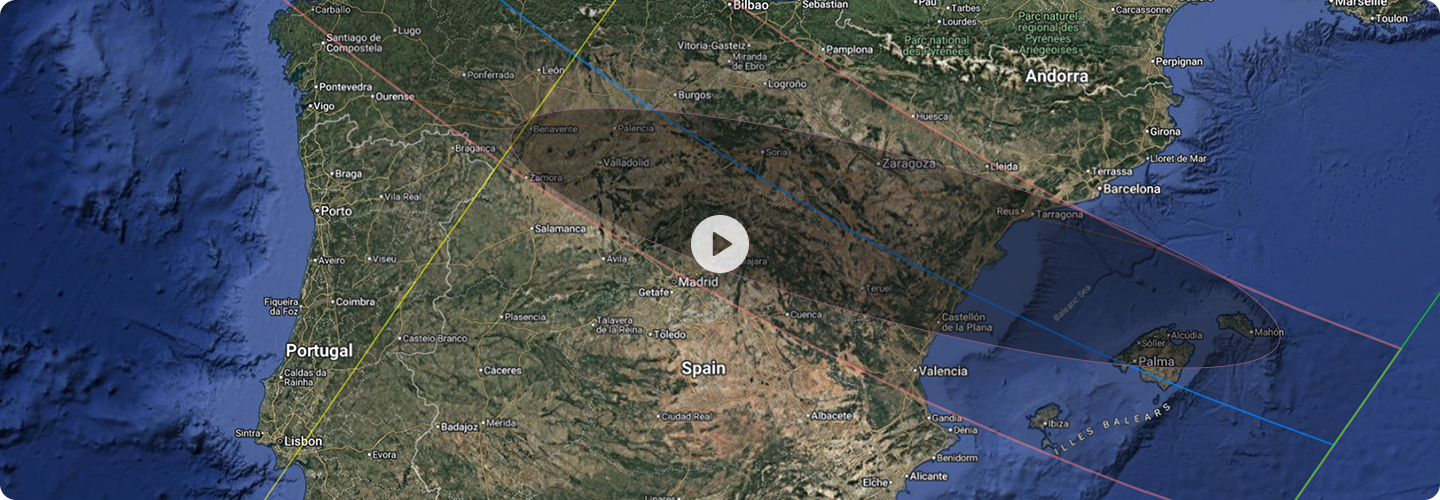
The Spanish National Geographic Institute provides an interactive tool that shows the path of the shadow as it crosses Spain, allowing you to identify suitable locations.
It is difficult to overstate the difference between experiencing a total eclipse and observing even a 99.9% partial eclipse . While 99.9% obscuration may resemble twilight, true totality transforms the sky into something much closer to night, complete with visible stars. The experience of a total eclipse is not a matter of degree but of kind—partial coverage, no matter how deep, cannot replicate the unique visual phenomena of totality.
The Sun is so intensely bright that even a fraction of its surface still illuminates the sky at extraordinary levels. With only 1% of the Sun exposed, it still provides around 10,000 times the brightness of a full moon. Even at 0.1%, the sky remains too bright to reveal the solar corona—the ethereal halo of plasma surrounding the Sun—that is visible only during totality.
As the Moon fully covers the Sun, distinctive effects occur. Just moments before totality, points of light shimmer around the darkened lunar edge, caused by sunlight filtering through valleys along the Moon’s limb. These flashes are known as Baily’s beads, named after astronomer Francis Baily. They are followed by the famous “diamond ring” effect, one of the most dramatic and unforgettable sights in astronomy.
The message is simple: get into the path of totality. Even if you are only a short distance away, outside the path you will miss these defining features of the eclipse. Only within totality will you see the solar corona, the diamond ring, Baily’s beads, and the sudden deep twilight that makes a total eclipse so extraordinary.
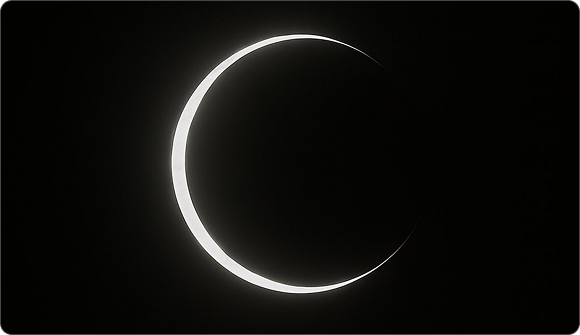

2. Terrain and unobstructed view
Viewing the eclipse in Spain is complicated by the Sun’s low altitude: only about 10 degrees above the horizon on the north coast and a mere 4 degrees at the Balearic Sea during totality. This means the horizon must be completely clear of obstacles—hills, forests, or even distant haze—regardless of conditions elsewhere in the sky. In the later parts of the track, special care is needed to avoid elevated terrain or poorly placed tree lines that could block the view.
The Iberian Peninsula’s rugged topography shapes the eclipse path with three mountain ranges, two elevated central plateaus, a broad river valley, and two coastal plains. To the north, the Cordillera Cantábrica acts as a barrier, trapping Bay of Biscay moisture along the coastal lowlands and limiting its intrusion inland. Some gaps exist, particularly between Bilbao and Burgos, but even there the 1,000-metre heights northeast of Burgos typically slow the advance of moist Atlantic air.
In central Spain, the shadow crosses a more complex landscape. North of the central line lies the low-lying Ebro River Basin, while to the south it passes over the Meseta Central, a plateau at 600–700 metres elevation. The Meseta is divided into northern and southern sections by the Sierra de Guadarrama, a mountain chain north of Madrid. The Guadarrama rises roughly 1,000 metres above the plateau, with peaks reaching up to 2,400 metres.
Farther east, the Sistema Ibérico begins near Burgos and sweeps southward. Initially north of the eclipse line, it eventually spreads across much of the southern track before reaching the Mediterranean. This system is not a single chain but a loose collection of at least seven smaller ranges and massifs, forming a natural divide between the Meseta, the Ebro Basin, and the Mediterranean coast. Elevations are moderate, with peaks around 2,300 metres.
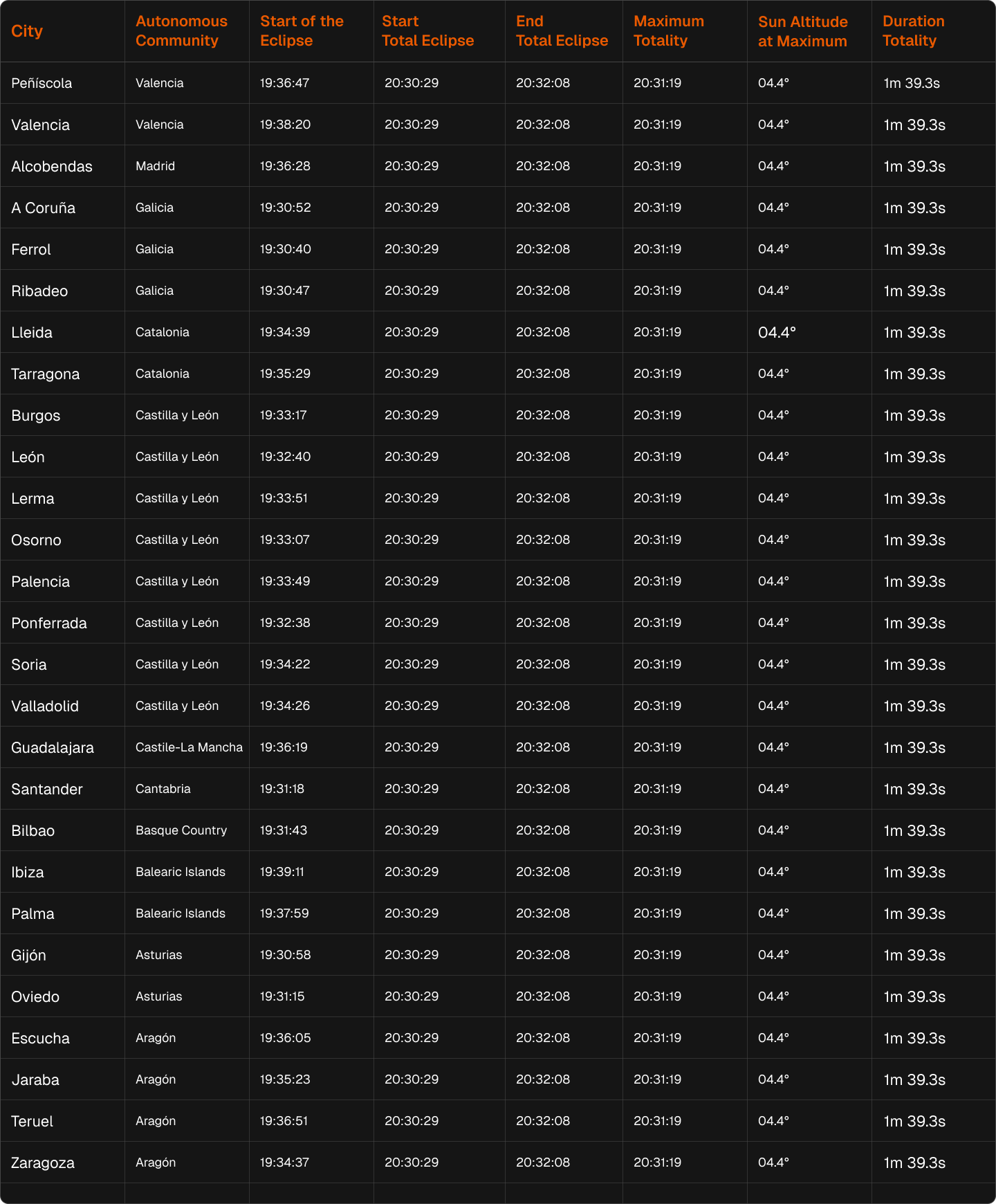
Madrid & Barcelona
Spain’s two largest cities lie just outside the path of totality. Madrid will experience 99.96% coverage and Barcelona 99.82%. While dramatic, these views do not compare to totality. If possible, residents and visitors are strongly encouraged to travel into the path.
If you know of ideal spots to watch the eclipse, please share them with others in the Discussion group below.
Please add photos, coordinates, anything you like.

3. Cloud and Weather Patterns Across Spain for the 2026 Total Solar Eclipse
The Iberian Peninsula’s rugged topography plays a decisive role in shaping cloud climatology along the eclipse track. Satellite data reveal that elevated terrain tends to coincide with increased cloudiness, while lower basins and valleys are markedly clearer. On average, conditions across much of the central eclipse track hover near 35% cloud cover, though local geography can tilt the odds toward either sunny skies or dense clouds.
- Mountains, Forests, and Convective Cloudg
Spain’s mountain ranges are pivotal in the development of summer cloud cover. When moist air rises against the Cordillera Cantábrica, the Sistema Ibérico, or the Sierra de Guadarrama, it cools and condenses into clouds. Dense, dark forests across these mountains absorb solar heat, warming quickly under August sun and feeding convection. As a result, cloud buildup is common over uplands, while adjacent basins and valleys remain clearer. Satellite imagery confirms these contrasts, showing cloud blossoming over forested areas north of Madrid and across the Sistema Ibérico.
- The North Coast: A Poor Prospect
The northern Atlantic coast along the Bay of Biscay is one of the least promising locations for eclipse viewing. Average August cloud cover reaches 60%, and historical data show that eclipses on August 12 would have been visible only about half the time in the past two decades. Northerly winds often drive stratus and stratocumulus clouds inland, while passing cold fronts enhance cloudiness and rain. Convective storms also occur, especially behind frontal systems. In addition to higher cloudiness, the coast experiences cooler temperatures and significantly more rainfall than other areas along the eclipse path. Coastal cities such as Oviedo, Bilbao, and A Coruña thus have the lowest sunshine statistics and pose substantial risks for eclipse chasers.
- Crossing the Cordillera Cantábrica
Once past the Cantabrian mountains, conditions change abruptly. The mountains block much of the Atlantic moisture, creating a sharp divide between cloudy and clearer regions. Along the eclipse centerline, cloud cover drops quickly into the 35% range. However, the mountains’ effect is less pronounced toward the north edge of the track, where Atlantic influence seeps farther inland, reaching Logroño, Pamplona, and nearly Burgos. Satellite traces confirm this gradient, showing a steep improvement on the centerline but a slower transition along the north limit.
- Meseta Central: A Reliable Bet
The broad Meseta Central plateau offers some of the best opportunities for clear skies. Northern basin cities such as León, Burgos, and Valladolid enjoy August sunshine between 68–78%. Out of 21 satellite-monitored years, eclipses would have been clearly visible on 17 dates. In the southern basin, locations like Madrid, Cuenca, and Guadalajara sit within Spain’s sunniest zones, offering reliable viewing potential. Differences between sites across the Meseta are relatively small—usually less than 10% variation in average cloud cover—giving observers a broad range of viable options.
- Sierra de Guadarrama: Beautiful but Risky
The Sierra de Guadarrama, just north of Madrid, stands out as both a scenic and problematic choice. The mountain chain is forested and prone to cloud development. A “finger” of increased cloudiness extends from Soria toward Plasencia, marking the Sierra’s influence. This adds roughly six percent more cloudiness compared with surrounding areas. While locals flock to these mountains for cooler air and summer recreation, eclipse seekers will need to carefully scout vantage points, as treed slopes and the low evening solar altitude pose challenges.
- Sistema Ibérico: Complex Terrain, Mixed Odds
The Sistema Ibérico is a sprawling mountain system that complicates the eclipse climatology. While cloud cover maps might appear discouraging, actual measurements are less severe, typically ranging from 35% to 45%. Sunshine statistics for Logroño (67%) and Soria (73%) reinforce the relatively decent prospects. Still, the combination of rugged landscapes, convective cloud, and the low altitude of the eclipsed Sun make the region a calculated gamble. Scenic vistas are plentiful, but clarity may not always cooperate.

4. Traffic and Travel During the 2026 Solar Eclipse in Spain
Planning to witness the 2026 solar eclipse in Spain? Be prepared—roads are expected to be heavily congested, and traffic could grind to a halt as people flock to prime viewing locations. Based on past eclipses (like in the U.S. in 2024), local authorities in Spain are anticipating spikes in traffic and tourist movement, especially along the path of totality.
Parking will also pose a major challenge. Many popular spots may lack designated lots, leading drivers to use roadside shoulders or shoulders—as makeshift parking zones. This puts further strain on traffic flow and can create bottlenecks, making even short trips cumbersome. A traveler on a forum related to the 2017 U.S. eclipse recalled:
“Traffic here from day trippers was INSANE, including people parking illegally along the interstate and interfering with traffic.” Rick Steves Community
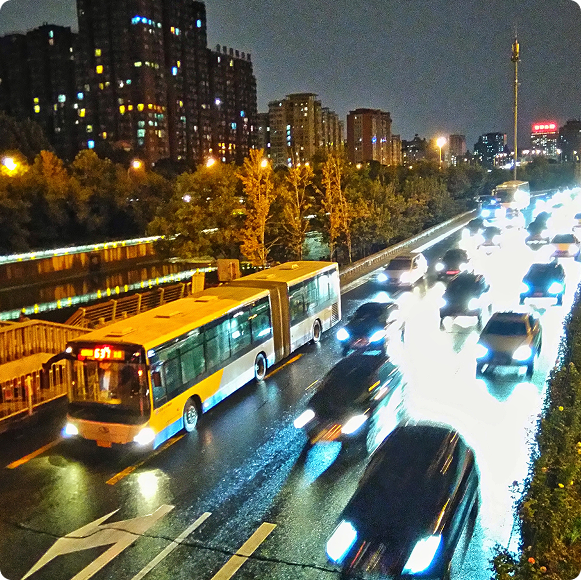
Smart Strategies to Avoid the Gridlock
1. Arrive Early and Settle In
To avoid post-eclipse chaos, travel experts advise arriving well before totality—even considering arriving in the early afternoon or even spending the previous night in your viewing town. This minimizes the pressure of last-minute arrivals and offers a smoother experience.
2. Make the Viewing Site Your Final Destination
Instead of rushing back to cities afterward, plan to stay put in your viewing location. Following the eclipse, roads may become nearly impassable. One chaser warned:
“Do not attempt to drive back to Madrid…
or Barcelona right after the eclipse, or you'll be queuing with perhaps millions of people.”
Savvy eclipse-watchers recommend turning your viewing day into a relaxed experience: pack food and drinks, set up a picnic, maybe even enjoy a hike while waiting for the celestial show.
3. Opt for Rural “Pueblos” Over Cities
Cities like Burgos, Bilbao, Segovia, or Palma on the Balearic Islands have better services and accommodations—but these same advantages will draw crowds and congestion. Smaller villages offer tranquility, easier parking, and lower traffic. Roads in rural Spain are well-maintained, making them… viable—but accessing very remote spots may still require advanced planning.
4. Book Travel and Lodging Early
With demand surging, places are filling fast. Hotel prices are already rising, and rooms are close to full capacity according to travel websites.
Transportation Options to Consider
By Car:
Offers flexibility if you're heading to a rural or off-grid spot. Just make sure to arrive early to secure a parking spot.
By Train:
Spain’s high-speed RENFE trains (like AVE) offer quick access between major cities—e.g., Madrid to Zaragoza in under 90 minutes. Perfect if your destination has a nearby station.
Driver or Transfer Services:
Ideal if you want convenience without driving. Book in advance to avoid last-minute road stress.
Best places to watch the spain 2026 solar eclipse
The August 12, 2026 total solar eclipse will be a once-in-a-lifetime event for Spain, offering millions the chance to experience totality for the first time in more than a century.
Yet choosing the right location is critical: the Sun will be very low in the sky—just 10° above the horizon on the north coast and falling to barely 4° by the time the shadow reaches the Balearic Sea. This makes an unobstructed western horizon absolutely essential, as even small hills, forested ridges, or haze can block the view.
Cloud patterns add a further challenge. The northern Atlantic coast, including Oviedo, Bilbao, and A Coruña, suffers from frequent cloud cover—around 60% on average in August—making it the riskiest option despite long totality durations. In contrast, once past the Cantabrian mountains, the Meseta Central offers far better odds. Cities such as Valladolid, León, and Madrid typically enjoy over 70% of possible sunshine in August, with satellite records showing clear skies on the majority of past eclipse dates.
For those seeking the most reliable weather prospects, the Ebro Valley—particularly Zaragoza and Huesca—stands out. With cloud probabilities below 30% and an excellent record of clear skies, this region provides the best balance of favorable climatology, good accessibility, and sufficient eclipse duration. The Sierra de Guadarrama and Sistema Ibérico offer scenic mountain settings, but their higher cloud frequency makes them more uncertain choices. Finally, the Balearic Islands provide a dramatic low-horizon spectacle, though success here depends heavily on crystal-clear skies.
See Conclusion table
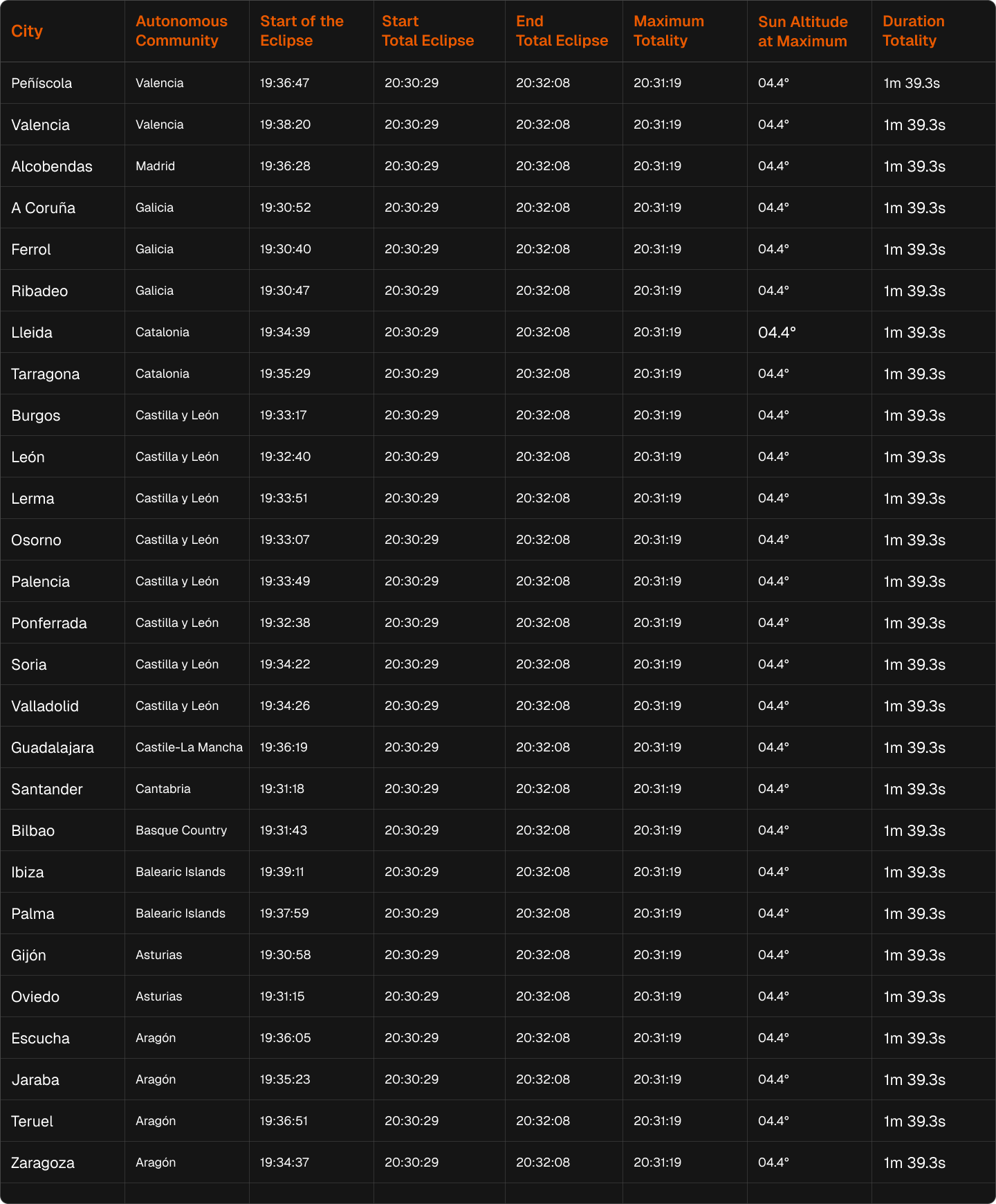
If you know of ideal spots to watch the eclipse, please share them with others in the Discussion group below.
Please add photos, coordinates, anything you like.

